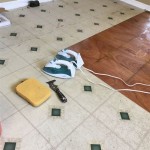Laying Vinyl Tile on Concrete Floor: A Comprehensive Guide
Vinyl tiles, prized for their durability, water resistance, and aesthetic appeal, provide an excellent flooring option for concrete surfaces. Laying vinyl tile on concrete is a manageable task that can transform the ambiance of a space. However, ensuring a flawless installation necessitates careful planning and meticulous execution. This guide outlines the essential steps involved in laying vinyl tile on a concrete floor.
1. Preparing the Concrete Floor
Thoroughly clean the concrete floor to eliminate any dirt, debris, or dust that could interfere with adhesion. Repair any cracks or uneven surfaces using a self-leveling compound or concrete patch to create a smooth, level substrate for the vinyl tiles.
2. Installing an Underlayment
An underlayment provides cushioning and sound insulation, enhancing the comfort and longevity of the vinyl tiles. Choose an underlayment that is compatible with both concrete and vinyl tiles and provides the desired level of support. Roll out the underlayment over the prepared concrete floor, securing it with tape or adhesive where necessary.
3. Planning the Layout
Determine the layout of the tiles before beginning installation. This includes calculating the number of tiles needed, considering the size and shape of the room, and planning for any borders or decorative patterns. Start from the center of the room and work outwards, ensuring the tiles are aligned straight and level.
4. Applying Adhesive
Use a flooring adhesive specifically designed for vinyl tiles on concrete. Apply the adhesive evenly to the underlayment using a notched trowel, following the manufacturer's instructions. Avoid using too much adhesive, as excess can squeeze out and compromise the bond.
5. Laying the Tiles
Carefully lift each tile and place it in the designated location on the adhesive. Press down firmly to ensure good adhesion. Use spacers to maintain uniform spacing between the tiles. If necessary, trim tiles around obstacles or edges using a utility knife.
6. Rolling and Trimming
Once all the tiles are laid, roll over the entire surface using a heavy roller to ensure proper bonding and eliminate any air bubbles. Trim any excess tile around the edges to create a clean, finished look.
7. Grouting and Sealing
For vinyl tiles with beveled edges, grouting is recommended to fill the gaps and prevent dirt accumulation. Use a grout that is compatible with vinyl and apply it using a grout float. Once the grout has dried, seal the tiles with a protective sealant to enhance durability and resistance to stains and moisture.
Additional Tips
- Before starting the installation, allow the vinyl tiles and concrete floor to acclimate to room temperature for 24-48 hours to prevent expansion or contraction issues.
- Use a chalk line to mark straight lines and ensure the tiles are aligned properly.
- Clean up any excess adhesive immediately to prevent staining.
- Allow the adhesive to cure completely before using the floor to ensure a strong bond.
- Regularly clean and maintain the vinyl tile floor using a damp mop and recommended cleaning solutions.

How To Prepare A Concrete Floor For Vinyl Flooring Parrys

Tips For Installing Vinyl Plank Over Concrete Floors Lemon Thistle

How To Install L And Stick Vinyl Tile On Concrete Floor Self Installation

Easy Ways To Install Vinyl Plank Flooring On Concrete

Concrete Subfloor Preparation For The Vinyl Floor Installation How To Diy Mryoucandoityourself

Installing Vinyl Floor Tile On Cement Garage Basement

How To Install Vinyl Or Laminate Floors In A Basement Over Concrete Slab

How To Install L And Stick Vinyl Tiles Houseful Of Handmade

How To Install Vinyl Flooring On Concrete Floor Ers

Vinyl Flooring Pros And Cons Forbes Home
See Also







